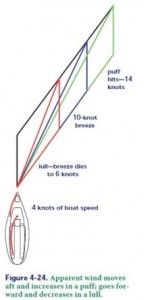Lulls and Puffs
As you sail along you may suddenly feel a dramatic drop in wind strength. You have sailed into a lull, and the apparent wind has gone forward and decreased because your boat speed is now a greater factor than the wind speed, until the boat slows down. Conversely, you might also see a puff—a big patch of ripples approaching you—the apparent wind moves aft and increases, and you suddenly feel a strong increase in wind strength because the wind speed is a greater factor than boat speed.
In Figure 4-24, initially the wind speed was 10 knots and the boat speed was 4 knots. The extension of the true wind line indicates a puff with a 4- knot increase. The apparent wind moves aft as the puff hits; but by the time your boat picks up speed, the puff has usually passed. When a puff is very strong, it causes your boat to heel dramatically if you don’t make any adjustments.
wind speed was 10 knots and the boat speed was 4 knots. The extension of the true wind line indicates a puff with a 4- knot increase. The apparent wind moves aft as the puff hits; but by the time your boat picks up speed, the puff has usually passed. When a puff is very strong, it causes your boat to heel dramatically if you don’t make any adjustments.
To reduce heeling when hit by a powerful gust, point the boat higher toward the wind. As the gust hits, apparent wind goes aft, causing more heeling and less drive. This changes the angle of attack—the angle the apparent wind makes with the sails.Now your sails are improperly trimmed until you head up or ease sheets or the traveler. This change in apparent wind direction is important to remember even on light days. On days when you have a 3-knot breeze, the wind velocity in a puff is apt to be more than double the regular breeze.When it is blowing 15 knots, gusts may get to only 20 to 22 knots—or about a third higher.
Thus, the change in apparent wind direction aft is often greater on light days than on heavy ones. But if the wind dies suddenly, apparent wind goes forward. In Figure 4-24, boat speed remains constant; when the wind velocity lowers to 6 knots, the apparent wind goes forward.








